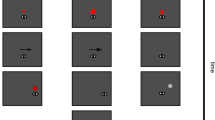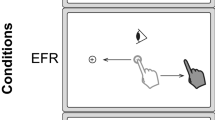Abstract
Eye as well as hand movements can adapt to double-step target displacements, but it is still controversial whether both motor systems use common or distinct adaptive mechanisms. Here, we posit that analyses of the concurrent adaptation of both motor systems to equal versus different double-steps may provide more conclusive evidence than previous work about the transfer of adaptation from one motor system to the other. Forty subjects adapted to double-steps which called for a change of response direction. The same (group S) or the opposite change (group O) was required for eyes and hand. Group ON equaled O, except that no visual feedback of the hand was provided. Groups E and H served as controls for eyes-only and hand-only adaptation, respectively. We found no differences between groups or motor systems when comparing S, E and H. Adaptation was faster in O than in S, E and H, and faster still in ON. However, the magnitude of eye adaptation was much smaller in O and ON than in S, E and H. We conclude that concurrent adaptation of eye and hand directions to opposite double-steps attenuates recalibration which, at least for the hand, is largely replaced by workaround strategies. The mechanisms for eye and hand adaptation therefore seem to be coupled, in a way that hinders divergent recalibration of both motor systems. The possible neuronal substrate for our findings is discussed.




Similar content being viewed by others
Notes
Saccade direction was defined, in analogy to pointing direction, as angular difference between primary target and saccade direction.
We thought five episodes were enough to estimate whether eye and hand adaptation differed.
The registered eye movements consisted of a primary saccade typically followed in double-step trials by a corrective saccade. Here, we analyze only the reaction time and direction of primary saccades.
The respective ANOVA outcomes were (F(29,377) = 5.68, p < 0.001); (F(29,377) = 4.6, p < 0.001); (F(29,377) = 5.4, p < 0.001) and (F(29,377) = 5.12, p < 0.001).
References
Alahyane N, Koene A, Pélisson D (2004) Transfer of adaptation from visually guided saccades to averaging saccades elicited by double visual targets. Eur J Neurosci 20:827–836
Alahyane N, Salemme R, Urquizar C, Cotti J, Guillaume A, Vercher J-L et al (2007) Oculomotor plasticity: are mechanisms of adaptation for reactive and voluntary saccades separate? Brain Res 1135:107–121
Andersen RA, Buneo CA (2002) Intentional maps in posterior parietal cortex. Annu Rev Neurosci 25:189–220
Asanuma C, Andersen RA, Cowan WM (1985) The thalamic relations of the caudal inferior parietal lobule and the lateral prefrontal cortex in monkeys: divergent cortical projections from cell clusters in the medial pulvinar nucleus. J Comp Neurol 241:357–381
Becker W, Jürgens R (1979) An analysis of the saccadic system by means of double step stimuli. Vis Res 19:967–983
Biguer B, Jeannerod M, Prablanc C (1982) The coordination of eye, head, and arm movements during reaching at a single visual target. Exp Brain Res 46:301–304
Bock O (2005) Components of sensorimotor adaptation in young and elderly subjects. Exp Brain Res 160:259–263
Bock O, Abeele S, Eversheim U (2003) Human adaptation to rotated vision: interplay of a continuous and a discrete process. Exp Brain Res 152:528–532
Bock O, Worringham C, Thomas M (2005) Concurrent adaptations of left and right arms to opposite visual distortions. Exp Brain Res 162:513–519
Bock O, Schmitz G, Grigorova V (2008) Transfer of adaptation between ocular saccades and arm movements. Hum Mov Sci 27:383–395
Clower D, Boussaoud D (2000) Selective use of perceptual recalibration versus visuomotor skill acquisition. J Neurophysiol 84:2703–2708
Clower DM, Hoffman JM, Votaw JR, Faber TL, Woods RP, Alexander GE (1996) Role of posterior parietal cortex in the recalibration of visually guided reaching. Nature 383:618–621
Cotti J, Guillaume A, Alahyane N, Pelisson D, Vercher JL (2007) Adaptation of voluntary saccades, but not of reactive saccades, transfers to hand pointing movements. J Neurophysiol 98:602–612
Courjon JH, Olivier E, Pélisson D (2004) Direct evidence for the contribution of the superior colliculus in the control of visually guided reaching movements in the cat. J Physiol 556:675–681
Desmurget M, Pélisson D, Urquizar C, Prablanc C, Alexander GE, Grafton ST (1998) Functional anatomy of saccadic adaptation in humans. Nat Neurosci 1:524–528
Desmurget M, Pélisson D et al (2000) Functional adaptation of reactive saccades in humans: a PET study. Exp Brain Res 132:243–259
Deubel H (1987) Adaptivity of gain and direction in oblique saccades. In: O’Regan J, Levy-Schoen A (eds) Eye movements: from physiology to cognition. North Holland, Amsterdam, pp 181–191
Deubel H (1995) Separate adaptive mechanisms for the control of reactive and volitional saccadic eye-movements. Vis Res 35:3529–3540
Frens MA, Van Opstal AJ (1994) Transfer of short-term adaptation in human saccadic eye-movements. Exp Brain Res 100:293–306
Frens MA, Van Opstal AJ (1997) Monkey superior colliculus activity during short-term saccadic adaptation. Brain Res Bull 43:473–483
Gielen CC, van Asten WN (1990) Postural responses to simulated moving environments are not invariant for the direction of gaze. Exp Brain Res 79:167–174
Girgenrath M, Bock O, Seitz RJ (2008) An fMRI study of brain activation in a visual adaptation task: activation limited to sensory guidance. Exp Brain Res 184:561–569
Kröller J, De Graaf JB, Prablanc C, Pelisson D (1999) Effects of short-term adaptation of saccadic gaze amplitude on hand-pointing movements. Exp Brain Res 124:351–362
Lazar G, Van Laer J (1968) Adaptation to displaced vision after experience with lesser displacements. Percept Mot Scills 26:579–582
Lünenburger L, Kutz DF, Hoffmann KP (2000) Influence of arm movements on saccades in humans. Eur J Neurosci 12:4107–4116
Magescas F, Prablanc C (2006) Automatic drive of limb motor plasticity. J Cogn Neurosci 18:75–83
McLaughlin SC (1967) Parametric adjustment in saccadic eye movements. Percept Psychophys 2:359–362
Miall RC, Reckess GZ, Imamizu H (2001) The cerebellum coordinates eye and hand tracking movements. Nat Neurosci 4:638–644
Miall RC, Jenkinson N, Kulkarni K (2004) Adaptation to rotated visual feedback: a re-examination of motor interference. Exp Brain Res 154:201–210
Neggers SF, Bekkering H (2002) Coordinated control of eye and hand movements in dynamic reaching. Hum Mov Sci 21:349–376
Niechwiej-Szwedo E, McIlroy WE, Green R, Verrier MC (2005) The effect of directional compatibility on the response latencies of ocular and manual movements. Exp Brain Res 162:220–229
Noto CT, Watanabe S, Fuchs AF (1999) Characteristics of simian adaptation fields produced by behavioral changes in saccade size and direction. J Neurophysiol 81:2798–2813
Pélisson D, Prablanc C, Goodale MA, Jeannerod M (1986) Visual control of reaching movements without vision of the limb. II. Evidence of fast unconscious processes correcting the trajectory of the hand to the final position of a double-step stimulus. Exp Brain Res 62:303–311
Pesaran B, Nelson MJ, Andersen RA (2006a) Dorsal premotor neurons encode the relative position of the hand, eye, and goal during reach planning. Neuron 51:125–134
Pesaran B, Musallam S, Andersen RA (2006b) Cognitive neural prosthetics. Curr Biol 16:R77–R80
Redding GM, Wallace B (1996) Adaptive spatial alignment and strategic perceptual motor control. J Exp Psychol Hum Percept Perform 22:379–394
Schmitz G, Bock O, Grigorova V, Ilieva M (2010) Adaptation of eye and hand movements to target displacements of different size. Exp Brain Res 203:479–484
Seidler RD, Bloomberg JJ, Stelmach GE (2001) Context-dependent arm pointing adaptation. Behav Brain Res 119:155–166
Snyder LH, Batista AP, Andersen RA (2000) Saccade-related activity in the parietal reach region. J Neurophysiol 83:1099–1102
Snyder LH, Calton JL, Dickinson AR, Lawrence BM (2002) Eye-hand coordination: saccades are faster when accompanied by a coordinated arm movement. J Neurophysiol 87:2279–2286
Straube A, Fuchs AF, Usher S, Robinson FR (1997) Characteristics of saccadic gain adaptation in rhesus macaques. J Neurophysiol 77:874–895
Stuphorn V, Bauswein E, Hoffmann KP (2000) Neurons in the primate superior colliculus coding for arm movements in gaze-related coordinates. J Neurophysiol 83:1283–1299
Takeichi N, Kaneko CRS, Fuchs AF (2007) Activity changes in monkey superior colliculus during saccade adaptation. J Neurophysiol 97:4096–4107
Thomas M, Bock O (2010) Is sensorimotor adaptation to position- and velocity-dependent visual distortions based on distinct adaptive processes? Hum Mov Sci 29:179–186
Thomas M, Bock O (2012) Concurrent adaptation to four different visual rotations. Exp Brain Res 221:85–91
Tipper SP, Howard LA, Paul MA (2001) Reaching affects saccade trajectories. Exp Brain Res 136:241–249
van Sonderen JF, Denier van der Gon JJ, Gielen CCAM (1988) Conditions determining early modification of motor programmes in response to changes in target location. Exp Brain Res 71:320–328
Vercher JL, Magenes G, Prablanc C, Gauthier GM (1994) Eye-head-hand coordination in pointing at visual targets: spatial and temporal analysis. Exp Brain Res 99:507–523
Wang J, Sainburg RL (2003) Mechanisms underlying interlimb transfer of visuomotor rotations. Exp Brain Res 149:520–526
Werner W (1993) Neurons in the primate superior colliculus are active before and during arm movements to visual targets. Eur J Neurosci 5:335–340
Werner W, Dannenberg S, Hoffmann KP (1997a) Arm-movement-related neurons in the primate superior colliculus and underlying reticular formation: comparison of neuronal activity with EMGs of muscles of the shoulder, arm and trunk during reaching. Exp Brain Res 115:191–205
Werner W, Hoffmann KP, Dannenberg S (1997b) Anatomical distribution of arm-movement-related neurons in the primate superior colliculus and underlying reticular formation in comparison with visual and saccadic cells. Exp Brain Res 115:206–216
Wigmore V, Tong C, Flanagan JR (2002) Visuomotor rotations of varying size and direction compete for a single internal model in motor working memory. J Exp Psychol Hum Percept Perform 28:447–457
Acknowledgments
This work was supported by DFG exchange grant 436BUL113/148/0-1 and by DFG grant BO 649/8-5.
Author information
Authors and Affiliations
Corresponding author
Rights and permissions
About this article
Cite this article
Grigorova, V., Bock, O. & Borisova, S. Concurrent adaptation of reactive saccades and hand pointing movements to equal and to opposite changes of target direction. Exp Brain Res 226, 63–71 (2013). https://doi.org/10.1007/s00221-013-3411-x
Received:
Accepted:
Published:
Issue Date:
DOI: https://doi.org/10.1007/s00221-013-3411-x




